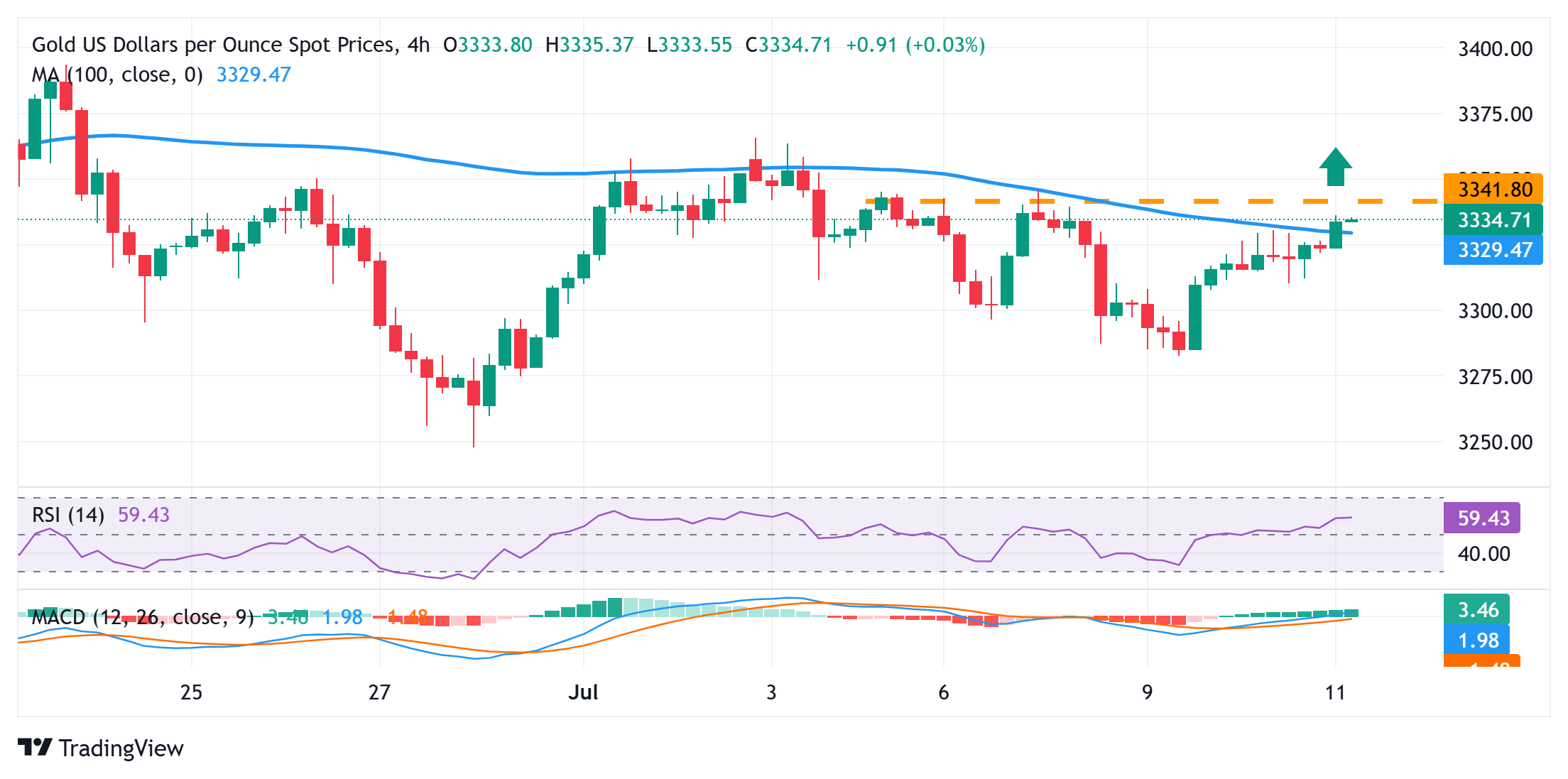- Gold price attracts buyers for the third straight day, though the upside seems limited.
- Rising trade tensions offset a broadly firmer USD and remain supportive of the move.
- Reduced Fed rate cut bets might hold back the XAU/USD bulls from placing fresh bets.
Gold price (XAU/USD) is gaining positive traction for the third consecutive day on Friday and approaching the top end of its weekly range amid rising trade tensions. In a dramatic escalation of trade wars, US President Donald Trump this week issued notices to a slew of trading partners, outlining individual tariff rates starting August 1 in the absence of any trade deals. This keeps investors on edge and takes its toll on the global risk sentiment, which, in turn, is seen as a key factor acting as a tailwind for the safe-haven precious metal.
Meanwhile, traders scaled back their expectations for an immediate interest rate cut by the Federal Reserve (Fed) following the release of the upbeat US monthly jobs report last week. This assists the US Dollar (USD) to stand tall near its highest level in more than two weeks touched on Thursday, and might hold back traders from placing aggressive bullish bets around the non-yielding Gold price. Hence, it will be prudent to wait for strong follow-through buying before positioning for any further near-term appreciating move for the XAU/USD pair.
Daily Digest Market Movers: Gold price continues to attract safe-haven flows amid trade jitters
- US President Donald Trump announced a 35% tariff on Canadian imports, effective August 1. The decision was conveyed in a letter, which marks the latest in a string of over 20 similar tariff notices Trump has issued since Monday. This comes following Wednesday’s announcement of a 50% tariff on US copper imports and continues to drive safe-haven flows towards the Gold price.
- Minutes from the Federal Reserve’s June 17-18 policy meeting showed that most policymakers remain worried about the risk of rising inflationary pressure on the back of Trump’s aggressive trade policies. The Minutes also revealed that only a couple of officials felt interest rates could be reduced as soon as this month, assisting the US Dollar to stand firm near a two-week top set on Thursday.
- On the economic data front, the US Department of Labor (DOL) reported that Initial Jobless Claims fell to 227K for the week ending July 5. This was less than the estimates and the previous month’s downwardly revised reading of 232K. This, along with stronger US employment details released last Thursday, points to a resilient US labor market and signals no urgency for the Fed to cut rates.
- Meanwhile, San Francisco Fed President Mary Daly said that monetary policy is still restrictive, and it’s time to think about adjusting the interest rate. Tariffs aren’t as high as they were expected to be, and economic fundamentals support a move toward lower rates at some point, Daly added further.
- Separately, Fed Board of Governors member Christopher Waller noted that tariff inflation effects are likely to be short-lived and that a rate cut here would not be politically motivated. Waller – one of the possible favorites to replace Powell in 2026 – made another push for an early interest rate cut in July.
- In contrast, St. Louis Fed President Alberto Musalem said that it was too soon to tell if tariffs will have a one-off or a more persistent impact on inflation. The economy is in a good place, and it is critical for the Fed to keep long-term inflation expectations anchored, Musalem added further.
- There isn’t any relevant market-moving economic data due for release from the US on Friday, leaving the USD at the mercy of comments from influential FOMC members. Apart from this, trade-related developments should contribute to providing some impetus to the XAU/USD pair on the last day of the week. At current levels, the commodity remains on track to end the week on a flattish note.
Gold price needs to climb beyond $3,340 to back the case for further near-term appreciation

From a technical perspective, some follow-through buying beyond the $3,340-3,342 horizontal barrier will confirm a breakout through the 100-period Simple Moving Average (SMA) on the 4-hour chart. This, along with slightly positive oscillators on the said chart, should pave the way for a further near-term appreciating move and lift the Gold price to the next relevant hurdle near the $3,360-3,362 region. The momentum could extend further and allow the XAU/USD pair to reclaim the $3,400 mark.
On the flip side, weakness below the $3,326 immediate support could attract some dip-buyers and help limit the downside for the Gold price near the $3,300 round figure. This is followed by the $3,283-3,282 region, or over a one-week low touched on Tuesday. A convincing break below the latter would make the XAU/USD pair vulnerable to accelerate the fall towards the July swing low, around the $3,248-3,247 area.
Tariffs FAQs
Tariffs are customs duties levied on certain merchandise imports or a category of products. Tariffs are designed to help local producers and manufacturers be more competitive in the market by providing a price advantage over similar goods that can be imported. Tariffs are widely used as tools of protectionism, along with trade barriers and import quotas.
Although tariffs and taxes both generate government revenue to fund public goods and services, they have several distinctions. Tariffs are prepaid at the port of entry, while taxes are paid at the time of purchase. Taxes are imposed on individual taxpayers and businesses, while tariffs are paid by importers.
There are two schools of thought among economists regarding the usage of tariffs. While some argue that tariffs are necessary to protect domestic industries and address trade imbalances, others see them as a harmful tool that could potentially drive prices higher over the long term and lead to a damaging trade war by encouraging tit-for-tat tariffs.
During the run-up to the presidential election in November 2024, Donald Trump made it clear that he intends to use tariffs to support the US economy and American producers. In 2024, Mexico, China and Canada accounted for 42% of total US imports. In this period, Mexico stood out as the top exporter with $466.6 billion, according to the US Census Bureau. Hence, Trump wants to focus on these three nations when imposing tariffs. He also plans to use the revenue generated through tariffs to lower personal income taxes.







